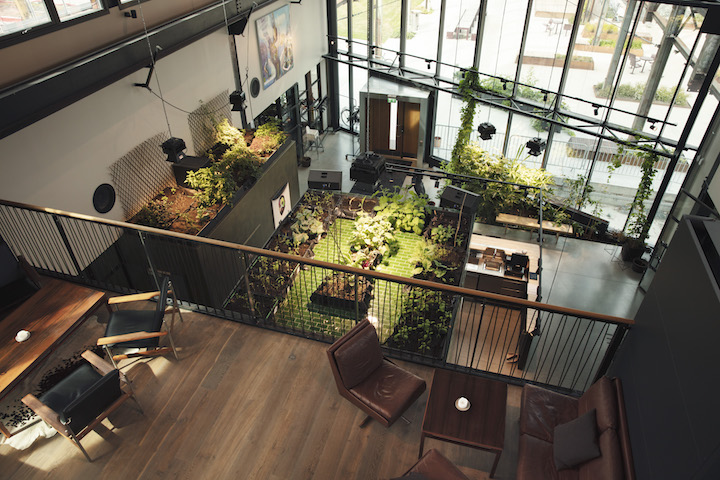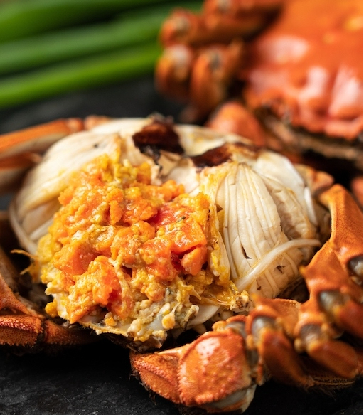Credo’s chef-owner Heidi Bjerkan says with a chuckle: “I also show the names of these cows so that diners can relate to the food on their plates and immerse in a bit of the farm experience.”
Putting prominence on provenance, one of the cow farmers also doubles up as a host to regale diners with anecdotes of rearing these cows to in the restaurant, which is housed in a former milk tank factory that is part of a sustainable redevelopment plan in a newly-constructed residential town in Trondheim.

For its impressive eco-friendly restaurant practices, Credo received the inaugural Sustainable Restaurant of the Year award in The MICHELIN Nordic Countries Guide 2019 in February. The MICHELIN Guide Digital caught up with Bjerkan, who was cooking at a kitchen jam event by the Norwegian Seafood Council in Singapore.
She cooked dishes using Norwegian shellfish such as grilled langoustine tail and soup, croustade filled with brown crab meat, horseradish mayonnaise and crab roe, and mahogany clams with unripe fermented redcurrants, elderflower and purslane.
Credo has also championed sustainable land use practices. Its 300 sq m farm grows many vegetables, micro-greens and fruit on soil that are enriched by compost generated from food waste. A minimal amount of pesticides are used as ducks waddle around to prey on slugs. A considerable amount of produce such as vegetables, meat, milk and sour cream are sourced from two farms, Fannremsgården and Skjølberg Søndre in the Trøndelag region, where the restaurant is located.
Signature dishes in Credo’s 20- to 26-course chef's tasting menu include grilled langoustine and fermented fruit; potetlompe, potato pancakes made with local potatoes and aged and fermented tubers.

Bjerkan also uses local grains to make sourdough bread, pasta and a beverage that contains water extracted from fermenting bread. She also uses every part of langoustine — her favourite shellfish — from its meat, tail and shell.
She says: “I hope to use my restaurant as a platform to get people to start thinking about new and alternative ways to reuse food and exploring more ways of supporting farmers.
Outside the kitchen, Bjerkan practices biodynamic farming, which is a holistic and spiritual approach to growing food sustainably. One such way is the regular rotation of crops. She says that it is crucial to plan the position of each crop in her farm so that an optimal amount of nutrients can be passed to the neighbouring crops.
She says: “Taking the sustainable route is the future. If you do not think about this, the world will not have a future.”
RELATED: Trondheim to host MICHELIN Guide Nordic Countries 2020 Star Revelation

1. How did your interest in sustainable cooking start?
I grew up surrounded by lots of natural produce. My grandfather was a fisherman, who brought seaweed and fish, and we grew carrots and potatoes in our farm. As I grew older, I started to pay more attention to the effects of climate change.
However, I became more interested in sustainable food practices after working as the executive chef for the royal family in Norway for eight years. There was a huge garden in the palace, which grew many vegetables and fruit. The more I got exposed to farming, the more knowledge I gained, which is key to saving the world.
2. What is the biggest challenge of implementing sustainable dining practices at Credo?
It is educating chefs to change their ways of preparing food and cooking when they are already so accustomed to their daily kitchen routines. It takes time to get them to realise the possibilities of using leftover food or recycling food waste as compost, instead of throwing them away.

My chefs have to work in farms to experience the harvesting process and understand the hard work behind cultivating produce. It is only then they will think twice about throwing ingredients away.
It is usually easier when these experiences are ingrained in them at a younger age, that’s why the average age of my kitchen staff is 20 years old. They have so much curiosity and take the initiative to find out more about the produce.
4. Which kitchen practice irks you most?
The excessive use of plastic in the food preparation process, such as using cling film and vacuum bags. Instead of plastic packaging, I store ingredients in glass containers and explore eco-friendly alternatives like beeswax paper.

People care more about how ingredients look than how they taste and discard ingredients that are not of the right shape and size. Crooked and odd-shaped carrots can actually taste amazing too.
Food waste is the worst thing to encounter in kitchens and it is sad that many kitchens still do not have the capacity and knowledge to think about alternative ways of maximising the uses of food.





















